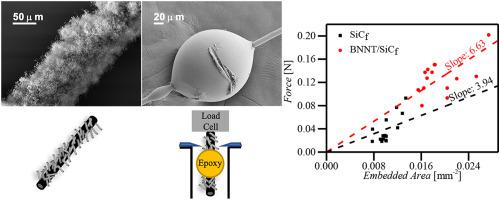Composites Science and Technology ( IF 8.3 ) Pub Date : 2021-09-08 , DOI: 10.1016/j.compscitech.2021.109033 Deniz Köken 1 , Ayşemin Top 2 , Fevzi Çakmak Cebeci 1, 3 , Fırat Turgut 2 , Beyza Bozali 2 , Elif Özden-Yenigün 4 , Nuri Solak 5 , Hülya Cebeci 2, 6

|
Tailoring the SiC fiber-matrix interface in micron-sized fibers is crucial to attaining enhanced mechanical properties in ceramic reinforced composites. Herein, the authors report the growth of boron nitride nanotubes (BNNT) onto SiC fibers (SiCf), creating a fuzzy fiber architecture to promote the surface area for a defined load path of fiber to the matrix and improve the mechanical properties of these structures. Successful BNNT-growth is achieved by a boron oxide chemical vapor deposition method combined with growth vapor trapping with optimum parameters of 1200 °C and 1 h, comparatively low temperature to those reported in the literature. The strength loss of SiCf after exposure to 1200 °C was attributed to high process temperature, similar to what has been observed in the literature. Hence, BNNT growth does not lead to additional strength loss on these fibers measured by a single fiber tensile test. Moreover, through this direct growth method, grown BNNTs utilize a surface-anchored BNNTs/SiCf, creating a good matrix adhesion to prevent fiber-fiber sliding and pullout and increasing the interfacial shear strength (IFSS) with epoxy. Furthermore, microbond tests show that fuzzy BNNTs/SiCf architecture increased IFSS by at least 87.8% compared to as-received SiCf.
中文翻译:

具有增强界面性能的分级BNNT/SiC纤维的有效生长
在微米级纤维中调整 SiC 纤维-基质界面对于在陶瓷增强复合材料中获得增强的机械性能至关重要。在此,作者报告了氮化硼纳米管 (BNNT) 在 SiC 纤维 (SiC f ) 上的生长,创建了一种模糊的纤维结构,以提高纤维到基体的定义负载路径的表面积,并改善这些结构的机械性能. BNNT 的成功生长是通过氧化硼化学气相沉积方法结合生长蒸汽捕集实现的,最佳参数为 1200°C 和 1 小时,与文献中报道的温度相比,温度相对较低。碳化硅f的强度损失暴露于 1200 °C 后归因于高工艺温度,类似于文献中观察到的情况。因此,BNNT 增长不会导致通过单纤维拉伸测试测量的这些纤维的额外强度损失。此外,通过这种直接生长方法,生长的 BNNTs 利用表面锚定的 BNNTs/SiC f,产生良好的基体粘附,以防止纤维-纤维滑动和拉出,并增加与环氧树脂的界面剪切强度 (IFSS)。此外,微键测试表明,与原样的 SiC f相比,模糊 BNNT/SiC f架构将 IFSS 提高了至少 87.8% 。









































 京公网安备 11010802027423号
京公网安备 11010802027423号